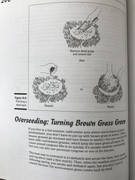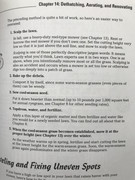theglassguy wrote: ↑October 30th, 2017, 8:52 pm
So, in other words, the greatest value of the books is as fire kindling?
You’d think with a name like “The Lawn Bible” they would have done some research. The author is the groundskeeper of Fenway Park (or at least he was). I’m Not sure what qualifications that actually gives him. I think I might rather a scientist or somebody at the national turf institute wrote this book rather than a guy who simply has learned from creating grass for sports fields, which is very different than grass for your front yard. That is unless your front yard is a football field
Right on!
On the idea of play-field grass growing strategies vs home lawn; I had a funny experience last year that I don't think I've admitted to until now...
A grounds keeper friend from a local golf course had a look at my lawn last fall when he heard I was planning an overseed. I showed him an area that was struggling to grow anything.
He came back a week later (right around when I threw my seed down) with a bag of "premium seed" from the course he maintained And "GUARANTEED that the seed [would] grow in my trouble spot". Not knowing any better, I threw the seed down mixed with my own and it filled the area in nicely - I now know that what sprouted that fall was MY seed and most of his lay dormant (keep reading to see why).
Next year as spring rolled around, I watched this section go from beautiful lush dark green grass to an explosion of nasty yellow-green grassy-weed material. No matter how much milorganite I threw at it, the area grew more and more yellow-green. It was also growing like the dickens - literally 2x to 3x faster than the rest of my turf. As I started to learn more about lawn care It was too late by the time I realized that the patch where this golf course quality seed lay from the previous fall was now... 99% poa annua! Come to find out, poa annua is very commonly used on the putting surfaces.

The area has since then been round-up nuked, and poorly re-seeded. I think my re-seeding efforts were poor due to an early-spring granular pre-m application which oddly seemed to have little effect on the poa sprouting.
It's now on my list of things to take care of next spring... I expect this mistake to take several years to correct as I'm sure a boat load of the poa seeded in the late spring before I nuked it...




